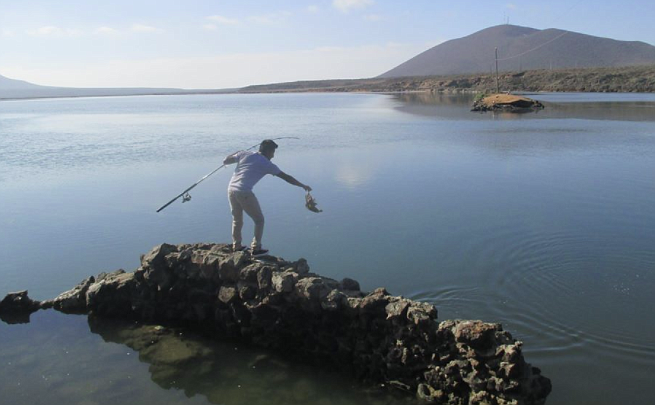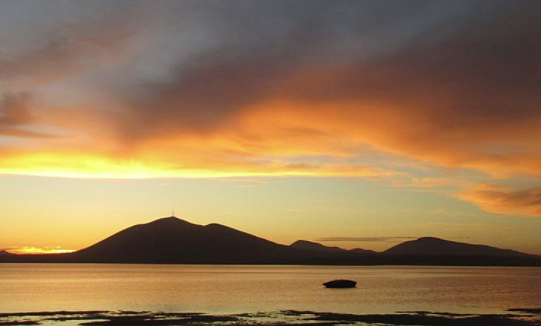 Facebook
Facebook
 X
X
 Instagram
Instagram
 TikTok
TikTok
 Youtube
Youtube

The following comes from a story posted on Daniel Powell's Facebook page.

The juvenile gray whale popped up off the end of the jetty on the eastern shore that separates the upper San Quintin Bay from the back bay. I was talking grouper fishing with Stephen, watching Cesar dive for octopus near where the whale surfaced. Fifteen minutes later it shot a breath of spume. The tide was starting to dump, the increasing current in the narrow divide between the bays already looking like a roiling river.

That was the first time I’d seen a whale north of the top end of Bahia Falsa, where the main channel takes a wide curve at the white buoy about three miles south of the Old Mill.

Sea lions and harbor seals frequent the upper and back bay as well. But, for the most part, the bay’s channels divide get shallower through the broad portion of upper bay.
I assumed the young whale left with that tide when we last saw its spume, but still went down to the Old Mill courtesy dock the next morning to toss some plastics for bass and grouper. As we saw it at the tip of the jetty and I didn’t think it was far into the mostly tidal Bahia Alta, I had assumed it was coming north and turned at the jetty. I saw whale spume out of the corner of my eye well into the back bay.
A couple kayakers entered the water to the north, both with fishing rods, and they soon paddled out near the whale, took a good look and started fishing the area. Folks started gathering in small groups along the shore to watch the whale.
The tide turned on that second day of the whale’s visit and I left when it was too fast to fish from shore. I had a thought on the way home that the whale might be trapped and not just taking advantage of the shrimp, crab and clam-rich tidal mud in Bahia Alta. There is a lot of old debris from past enterprise as well as chunky piles of lava rock.
By day three, Sunday, the yearling whale had a name: Moby Dick, given by a local ex-pat. Photos soon started appearing in the Baja-related Facebook feeds and folks were enthused to see a whale that far back in the bay. But not everyone was happy about it; the whale had been there too long, some felt, and with the slacking tide phase, it might well be trapped and die.
I last saw Moby Dick alive on Monday, four days after first seeing it. In the morning, in the back bay, it was there again but it seemed weak, its back barely breaking water, its spume feeble.
That afternoon, while pondering whale leashes, speaker boats or herding methods, I saw spume out in the bay in front of my house, about a mile south of the Old Mill. Then it blew again, to the south, and again; five times, each breath taken a little further south from the last. My hopes for the whale’s survival rose as the last spume disappeared in sun-glinted water to the south, about halfway between the Old Pier channel and the Pedregal Channel. I knew the tide was dropping and there is a shallow eelgrass covered sand bar there, but I had faith the whale would find its way back to deeper water and out of the bay.
About eight o’clock on Tuesday morning, I went up to the Old Mill and Don Eddies to toss lures again from shore and see if Moby Dick had returned, or hopefully, not, and made it out of the bay – or at least to deeper water with a more pleasant bottom to scoop and a chance at more food. I did not see it in the upper or back bay and that was a relief. As the day was glassy and the tide moderate when I returned home, I decided to paddle south to a deeper rocky stretch of shoreline. As I crossed the bay southward, I found Moby Dick, dead in the water not a quarter mile from where I last saw its spume the afternoon before.


The following comes from a story posted on Daniel Powell's Facebook page.

The juvenile gray whale popped up off the end of the jetty on the eastern shore that separates the upper San Quintin Bay from the back bay. I was talking grouper fishing with Stephen, watching Cesar dive for octopus near where the whale surfaced. Fifteen minutes later it shot a breath of spume. The tide was starting to dump, the increasing current in the narrow divide between the bays already looking like a roiling river.

That was the first time I’d seen a whale north of the top end of Bahia Falsa, where the main channel takes a wide curve at the white buoy about three miles south of the Old Mill.

Sea lions and harbor seals frequent the upper and back bay as well. But, for the most part, the bay’s channels divide get shallower through the broad portion of upper bay.
I assumed the young whale left with that tide when we last saw its spume, but still went down to the Old Mill courtesy dock the next morning to toss some plastics for bass and grouper. As we saw it at the tip of the jetty and I didn’t think it was far into the mostly tidal Bahia Alta, I had assumed it was coming north and turned at the jetty. I saw whale spume out of the corner of my eye well into the back bay.
A couple kayakers entered the water to the north, both with fishing rods, and they soon paddled out near the whale, took a good look and started fishing the area. Folks started gathering in small groups along the shore to watch the whale.
The tide turned on that second day of the whale’s visit and I left when it was too fast to fish from shore. I had a thought on the way home that the whale might be trapped and not just taking advantage of the shrimp, crab and clam-rich tidal mud in Bahia Alta. There is a lot of old debris from past enterprise as well as chunky piles of lava rock.
By day three, Sunday, the yearling whale had a name: Moby Dick, given by a local ex-pat. Photos soon started appearing in the Baja-related Facebook feeds and folks were enthused to see a whale that far back in the bay. But not everyone was happy about it; the whale had been there too long, some felt, and with the slacking tide phase, it might well be trapped and die.
I last saw Moby Dick alive on Monday, four days after first seeing it. In the morning, in the back bay, it was there again but it seemed weak, its back barely breaking water, its spume feeble.
That afternoon, while pondering whale leashes, speaker boats or herding methods, I saw spume out in the bay in front of my house, about a mile south of the Old Mill. Then it blew again, to the south, and again; five times, each breath taken a little further south from the last. My hopes for the whale’s survival rose as the last spume disappeared in sun-glinted water to the south, about halfway between the Old Pier channel and the Pedregal Channel. I knew the tide was dropping and there is a shallow eelgrass covered sand bar there, but I had faith the whale would find its way back to deeper water and out of the bay.
About eight o’clock on Tuesday morning, I went up to the Old Mill and Don Eddies to toss lures again from shore and see if Moby Dick had returned, or hopefully, not, and made it out of the bay – or at least to deeper water with a more pleasant bottom to scoop and a chance at more food. I did not see it in the upper or back bay and that was a relief. As the day was glassy and the tide moderate when I returned home, I decided to paddle south to a deeper rocky stretch of shoreline. As I crossed the bay southward, I found Moby Dick, dead in the water not a quarter mile from where I last saw its spume the afternoon before.
Comments